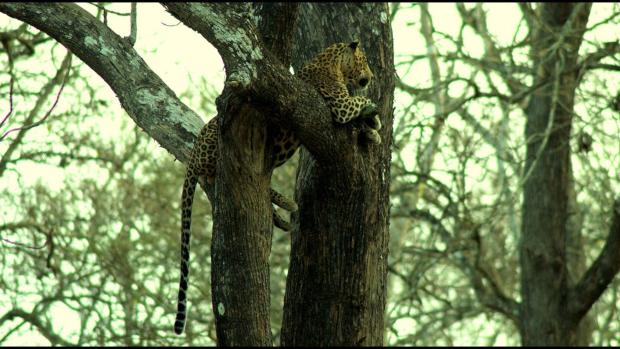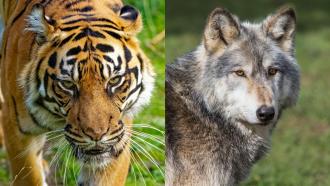
Photo: Ramya Badrinath/Research Matters
You’re sitting in the porch overlooking your backyard, sipping hot chai while admiring the trees. It’s night-time and you see something lurking behind one of the trees. Probably one of the neighbourhood dogs, you think, taking another sip. But then, the streetlight flickers on and then off immediately, but gives you enough time to see the dark patterns on the yellow body. A leopard in your backyard?! Is it possible, you may wonder. But the truth is, it very much is.
The leopard (Panthera pardus) is one among the five big cats, the other four being the tiger, lion, jaguar and the snow leopard. Of these, the leopard occupies the most diverse range of habitats -- desert and semi-desert regions, mountains, grasslands and even rainforests! This skill of adaptability leads them to persist in human dominated areas as well, preying on dogs and domestic cattle.
The Indian subspecies (Panthera pardus fusca) is distributed all over the country. Male Indian leopards can grow to lengths of 4 feet 8 inches with a 3 feet long tail, weighing up to 77 kg, while females are smaller, growing to lengths of 3 feet 10 inches, with a 2 feet 10.5 inch long tail and weighing up to 34 kg.
Leopards have rosettes, which are rose-shaped patterns on a yellowish brown or golden background on their body. Like a tiger’s stripes, every leopard’s rosette pattern is unique. They are mostly solitary and become active during the night (nocturnal). Sometimes, they be seen resting on branches of trees during the day. And again, like the tiger, these cats are also strong swimmers.
But this large cat is now listed as ‘vulnerable’ by the International Union for Conservation of Nature’s (IUCN) Red List, the most comprehensive database on the conservation status of biological species.
Leopards feed on a wide variety of animals, including insects, reptiles, birds, small mammals and even ungulates like wild boar and deer. By doing this, the leopard keeps the population of all these prey species in check, and hence plays an integral part in maintaining the stability of the ecosystem. But sometimes, leopards decide to attack humans as well. On 16 May 2017, a leopard attacked a toddler in Maharashtra. And on June 7, 2017, a biker was injured in a leopard attack in Karnataka.
In an email interview with Research Matters, we asked Mr. Nikit Surve, a wildlife biologist and conservationist in Mumbai who studies human-leopard conflict to tell us the reason behind the dwindling numbers of these elegant cats. “The leopard, being a highly adaptable cat, is found all across India including areas outside the protected areas. It is in these areas where the leopards face a lot of problems”, says Mr. Surve, opening up the dialogue. “As they come in close contact with humans, most of whom are not used to living with leopards, the leopards get translocated, moved to permanent captivity, or killed in certain states. Poaching is another major concern with respect to leopards as all the attention in India is diverted towards tigers, making leopards easy prey”, he reasons.
According to a recent report, 131 leopards have died since the beginning of this year. Of these, 78 died due to natural causes or in accidents, and poachers killed 53, says the WPSI (Wildlife Protection Society of India). It is shocking to note that we lose a leopard every two days!
There have been many instances where the forest department, which is entrusted with the protection of wildlife, has shot leopards when these cats have turned to killing humans. And when leopards have strayed into human dwellings, they are in many cases translocated, like Mr. Surve said and even killed by panic-driven people. But is there an alternative?
“The word ‘straying’ itself is misleading”, points out Mr. Surve. “The phenomenon of straying from natural systems into human dwellings by leopards is totally a human concept. Wild animals do not understand man-made boundaries! For them, as long as they get food, water and shelter, they will colonise that area if the conditions are favourable. And leopards being the most adaptable cats, they can easily exist in human dominated areas as these areas are rich in domestic prey such as cattle, stray dogs, pigs, cats and rodents”, he says talking about the why leopards are often found getting into the cities and villages.
Mr. Surve also reasons that removal of the animals by translocation from the areas where they are found, or killing them, is not the best solution because we only remove the animals and not the cause of the leopards being there. “Instead, it would result in a lot of trauma to the animals as when they are translocated, they come in close contact with humans and also their social system and hierarchy is disrupted”, he remarks.
“This could be one of the reasons why leopards, which are so scared of humans, switch to attacking and killing us. Many a times the females get separated from their cubs and hence they start attacking humans”, says Mr. Surve.
And is there a way out? “The way out of this is to remove the elements which attract the leopards towards human settlements i.e., removal of garbage which attracts stray dogs, pigs and cats and giving domestic livestock proper protection that prevents the leopards from killing them. And most importantly, there needs to be awareness spread amongst people about how to live with leopards by taking the necessary precautions”, opines Mr. Surve.
Mr. Surve adds that the society plays a major role in this conservation effort of saving India’s leopards. The simplest example would be that mere sighting of a leopard in your surroundings do not mean a threat. People need to realise this and stop panicking, as panic results in the removal of these animals, which further worsens the conflict scenario.
Nikit Surve, who works for Wildlife Conservation Society - India Program, has been interested in wildlife since his childhood. He currently studies leopards at the Sanjay Gandhi National Park in Mumbai and is working towards his Ph.D.
Before we end the interview, we ask Mr. Surve one last question. What would be his advice to young students who wish to have a career in the field of Wildlife?
“The only advice I would give is to be open-minded and not narrow-minded. This is applicable to each and every step in your career i.e., while selecting your field, while studying a particular issue, and also while finding solutions or remedies to the problem. Conservation cannot be only animal or people centric. It needs to have a holistic approach,” he says.
Mr. Surve’s words ring true. We need to think twice before bringing out the guns and tranquilizers. Most importantly, there needs to be a change in perception among people. We need to learn to coexist, and we can start by being aware of how our fellow creatures behave and by being more tolerant towards their presence.






